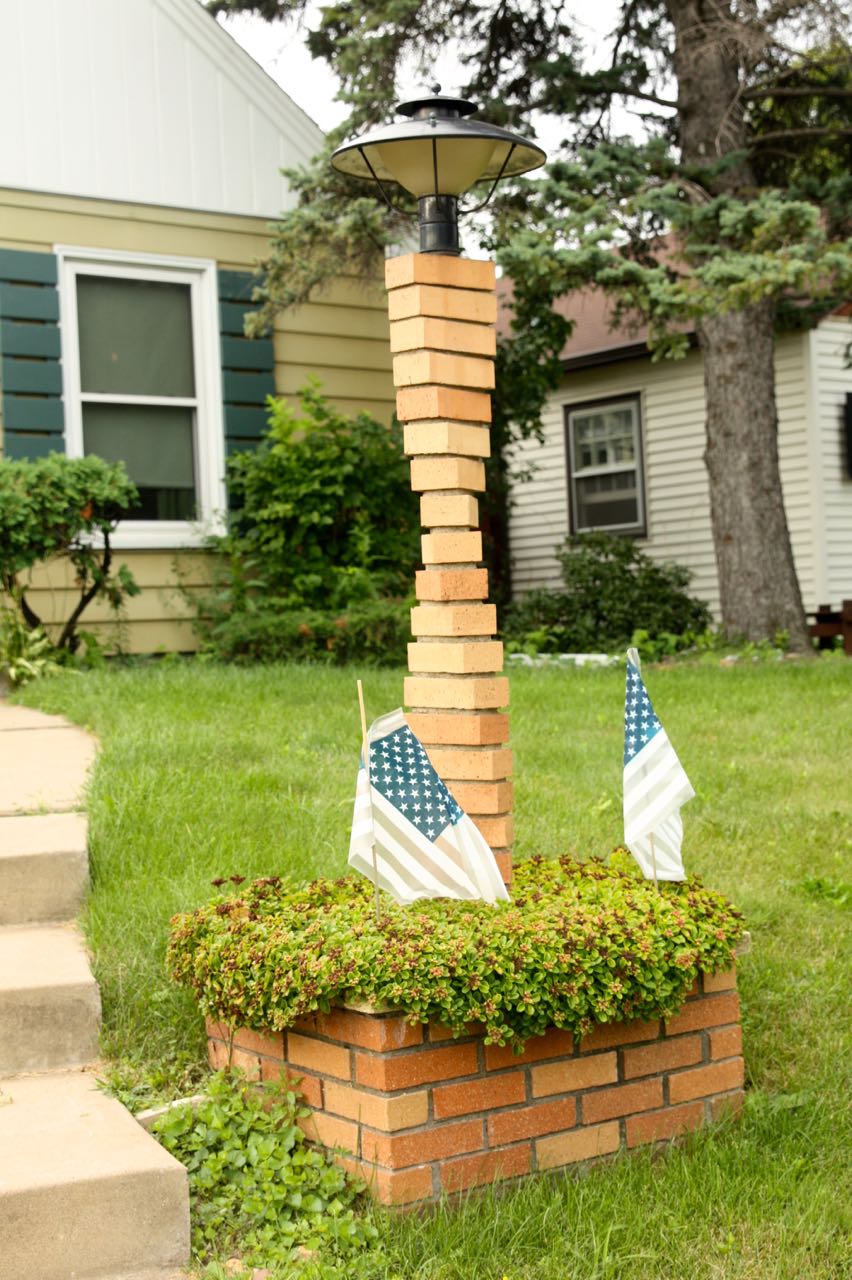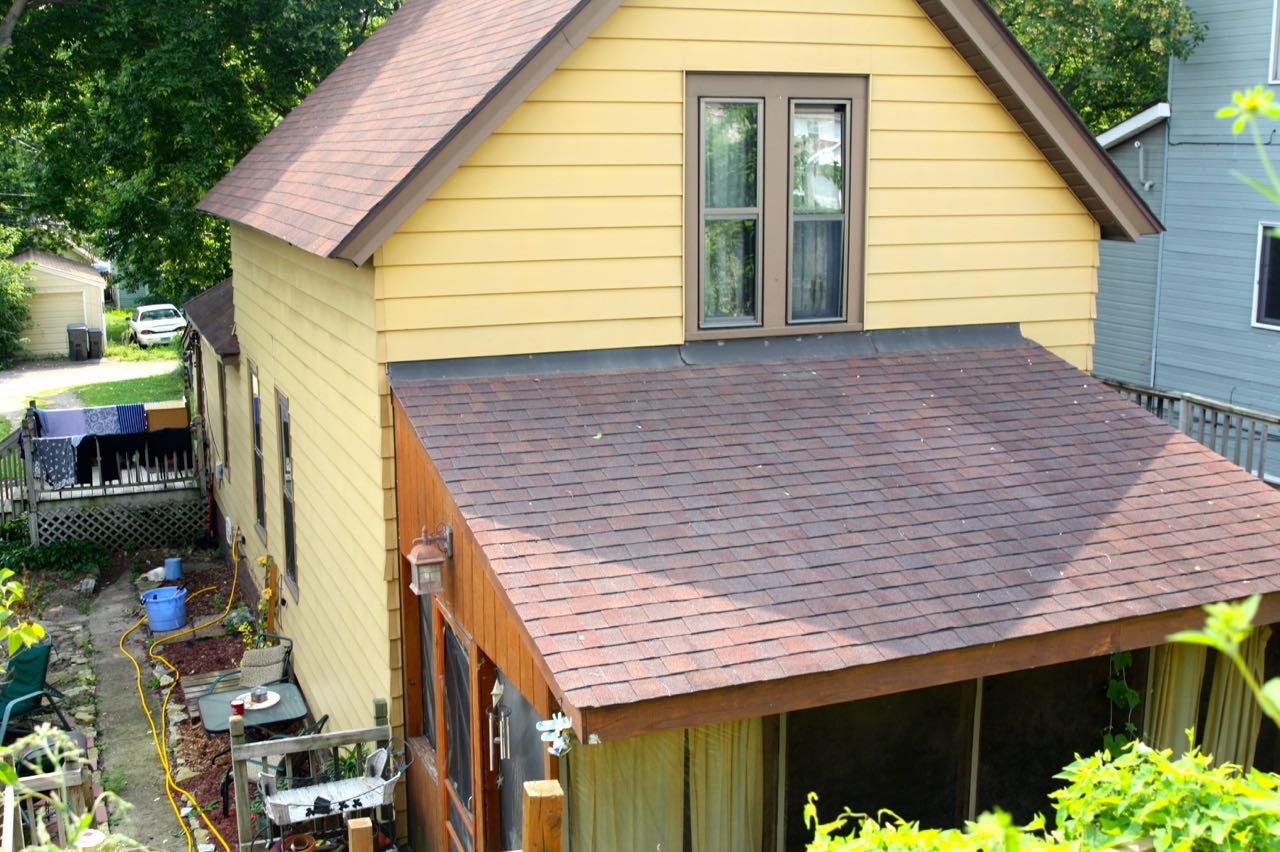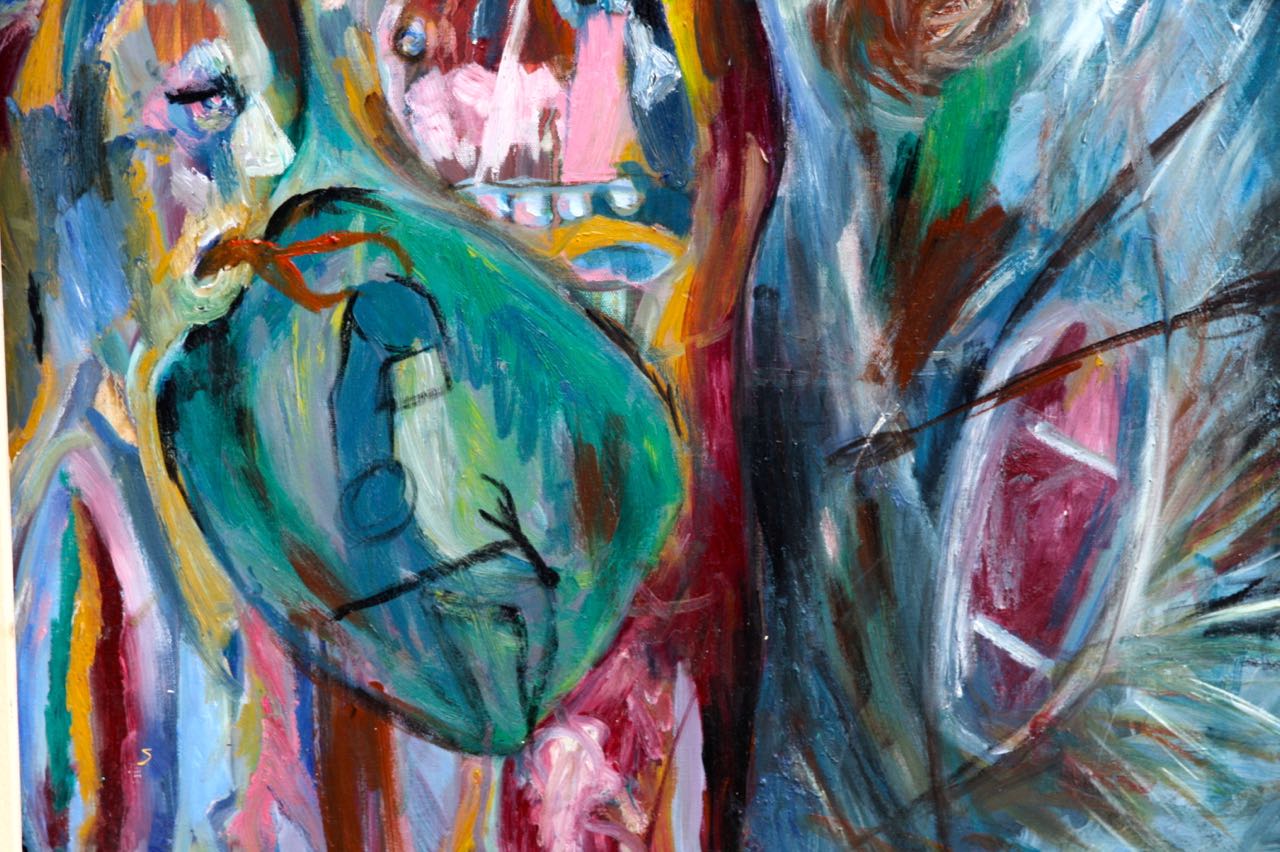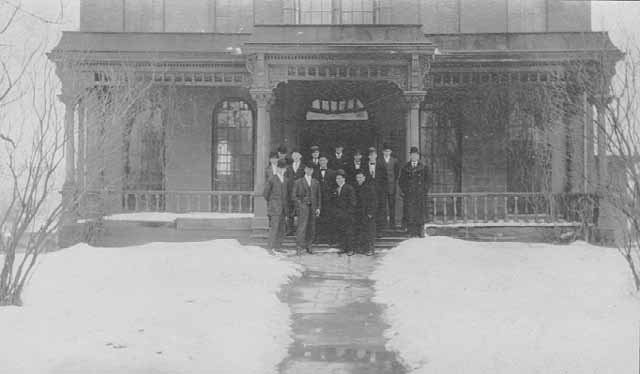August 22, 2015
13.2 Miles
Highland Park, West End (West 7th), Merriam Park
A pleasant, sunny Saturday was a good day to pick up some of the streets I’d missed on previous rides in the southwest side of the city. By southwest I mean Highland Park and the West End (a.k.a. West 7th).

The Mid-Century lamp dates to the early 1960s.
The mid century modern yard lamp in front of 2168 Highland Parkway is special. The lamp appears to be out of the 1960 or ‘61 Progress Lighting catalog I found with a quick Google search. Check out the custom brickwork placed around the lamp pole! That creative touch adds to its allure.

The 1960 Progress Light catalog. The lamp in the yard looks to be P 5419.
Some lucky children have cool grandparents who live at 1825 Benson Avenue. The log playhouse – with real windows – is a child’s dream

This log playhouse has working windows.

Many other fringe benefits are included with the play house.
The West End

The walking/bike path into the western part of Victoria Park.
This rundown and overgrown asphalt path leads curious hikers off Montreal Way at Adrian Street in the Crosby Park Business Center and into a large undeveloped tract of weeds and brush. Interspersed among the growth are many capped pipes – wells to monitor the groundwater beneath this former petroleum tank farm owned by Koch Industries and Exxon.

In 1970 oil tanks and railroad cars covered the area. Photo courtesy Minnesota Historical Society.

Those dark pipes with silver caps protruding from the earth are ground water monitors, reminders of the 36 acres of oil tanks that once resided here.

This remediation station is another sign of what used to sit on this land. The elevated fence sheathed by barbed wire obviously portends danger here.
Although there was much more to explore here, I chose to keep riding and investigate another day.
Meanwhile, just east, in the first phase of Victoria Park at 455 Victoria Way, is the home of Nova Classical Academy, one of Saint Paul’s most popular charter schools.

As its name says, a classical education, which includes Latin, is part of the Nova curriculum.
Continuing to explore the neighborhoods between West 7th and Shepard Road, I paused at the captivating stone home on the southwest corner of Stewart Avenue and Sumac Street. A look at the house gives no clue as to the unconventional narrative of the life of 698 Stewart Avenue. Built in 1862 for William and Susan Cullen, according to the AIA Guide to the Twin Cities by Larry Millett, the large home possessed a detailed cupola that was torn off by a tornado later in the 1860s. The home and vast grounds showcased spectacular views of the Mississippi River.

The stone block exterior, Victorian windows and unique look of the home at 698 Stewart nearly stopped me in my tracks.
The Protestant Orphan Asylum purchased the Cullen House in 1872. In “History of Ramsey County and the City of St. Paul” from 1881, Edward D. Neill described the property this way:

A description of the former Cullen property. From Edward D. Neill’s “History of Ramsey County and the City of St. Paul” written in 1881.
From there, the specifics seem to be lost. Years later, notes the AIA Guide, the Cullen House became a VFW Post and, “at some point lost its mansard roof and second story.”

The Cullen House was boarded up and roofless as late as 2001. Photo courtesy www.placeography.org and Joe Hoover.
The indignities suffered by the Cullen House were finally reversed in the late 2000s or early 2010s with a new second story, roof, and numerous other structural and aesthetic improvements. I knocked on the door of 698 Stewart to see if I could get the story on the rehabilitation, but found no one home.

Looking through the windows, you can make out the trees in the Mississippi Valley in the background.

The back of the Cullen Home.
Meanwhile, across Sumac Street to the north, is another consequential home of the same era. The William Banholzer House, built in 1885 in the French Second Empire style features common design cues such as a mansard roof, dormers, and a square center tower.

The Banholzer House is part of a large Hazelden drug and alcohol rehab facility on Stewart Avenue.

The Banholzer House has been used by Hazelden for years.
I find Second Empire-style homes among my favorites because of the multiplicity of windows and angles, the dormers, and intricate detailing above the porch and windows.

The parlor of the Frederick Banholzer home shows the jumble of of knickknacks and furniture common in Victorian era decorating. This photo was taken in 1885 shortly after the house was completed. Courtesy of the Minnesota Historical Society
The French Second Empire-style is often associated with haunted houses. Perhaps it’s their appearance in movies such as “Psycho” as the Bates’ Mansion and the Marsten House in “Salem’s Lot”.

The Bates’ Home from the movie “Psycho.” Courtesy www.retroweb.com
William Banholzer made his fortune brewing beer a short distance from his home at what today is Drake Street and Shepard Road. The brewery’s North Minnesota Beer was one of the state’s most popular brews until Banholzer’s untimely death in 1897 at age 48. About a year later the brewery was shuttered.

The center tower and part of the third floor of the Hazelden building.
It’s fun to contemplate how Banholzer would react to the ultimate disposition of his former house, which has been part of the Hazelden alcohol and drug rehab center for some 60 years.

This sign is prominently displayed next to the walkway up to the Hazelden building.

The second story window at 774 Stewart Avenue is at street level. There are several houses built below street level in this neighborhood.
If you’ve lived in or biked the West End, you know how hilly parts of it are. Seeing the unusual lay of homes like 774 Stewart really accentuate the rapid elevation change.

Here’s how 774 Stewart looks from the sidewalk.

From the alley behind the house you can see just how far below the street 774 Stewart is.
On to West 7th, also known on and off for decades as the Fort Road because it runs to Fort Snelling on the west. Construction of the three story red brick building, Ayd Hall, was completed in 1889. It still (or perhaps, again) has businesses on the street level and two floors of apartments above.

The Ayd Hall Apartment building at 1031-1035 West 7th Street.

The Ayd Hall building has this unconventional font in the name plaque.
Another nicely maintained West 7th landmark from before the turn of the 20th century is on the northwest corner of West 7th and Randolph. The Machovec Building was home to the family owned Machovec’s grocery from 1893 until July 2001 when owner Stan Machovec retired due his health, according to the Star Tribune newspaper.

Now a fast food restaurant with a garish yellow awning, 997 West 7th was the long-time spot of Machovec’s Grocery Store.
The Pilney Building was once home to another small family grocery store, not surprisingly called Pilney’s. This West 7th landmark is two blocks south and across the street from the Machovec Building. Pilney’s closed on May 28, 1999 – after 95 years – says the StarTribune from that day, when owner Lou Pilney retired. Now the much photographed Pilney Building houses several businesses.

The Pilney Building at West 7th Street and Osceola has captured the interest of passersby since its construction in 1908.

Fire Station 1 was built in 2010 on a triangular piece of land at West 7th and Randolph, resulting in unique curved windows facing Randolph. It’s the perfect spot to display the Department’s 1924 Ahrens-Fox pumper, which is difficult to see in this picture because of reflections.
The large, curved window facing West 7th Street at Randolph is the most arresting feature of Fire Station 1. (Yes, the verb ‘arresting’ is more fitting for a police station). Making it more captivating is the 1924 Ahrens-Fox NS2 pumper parked inside.
I thought the truck was part of an SPFD museum in the station. I also assumed said (non-existent) museum was open for public viewing. That explains the startled and quizzical looks I got from the firefighters who opened the door. Still, after explaining to me that this is a working fire station, not a museum, they invited me in to take some pictures.

The Ahrens-Fox pumper served the Saint Paul Fire Department from 1925 until 1951 when it was placed on reserve status. The rig was finally retired in 1969, according to a February 15, 2010 blog post by Fire Chief Tim Butler. http://saintpaulfirechief.blogspot.com/2010/02/arrival-of-engine-29.html
It was impossible to get a shot of the entire truck because of the close quarters inside the station.

The pumper still shines, almost like when it came off the assembly line. The two silver levers are foot pedals.

The purple van adorned with paintings required my investigation.
My next stop, also on West 7th near Randolph, was for another truck. The purple van displayed paintings along some of the windows and doors. Upon getting closer, I could see that the whimsical van was a mobile art exhibit, tended to by Gretchen Seichrist and Chris Thompson.

Chris Thompson (left) and Gretchen Seichrist (right) sit on their mobile art gallery van, which was parked on West 7th Street.

A passerby looks through Gretchen’s art along West 7th Street.
Gretchen calls herself a visual artist and musician. Often, Gretchen told me, she does both at the same time. “I’ll put paintings actually on the stage or it will be an element of performance art”.
“When we do music, sometimes we do it on the street. We just recently sold some of our equipment,” she said, “but usually we would be set up with battery powered amps…and play and then put out paintings; sometimes paint out here.”

Gretchen’s music is also for sale at the mobile art gallery.
The purple van, said Gretchen, was a recent addition to their artistic lifestyle. “It’s the first time I’ve had a vehicle that I could do whatever I wanted. We painted it one time – this is the second – it was all different, really bright colors. On the way back from Florida we let people write on it and paint on it. We’d talk to people on the way back and the different reactions changed state to state – everything from complete hostility to like really happy and you made my day kind of things. We’re always interested in those human reactions.”

Chris and Gretchen talk during a break from visitors. Fire Station 1 is in the background.
Art is not a hobby for Gretchen and Chris; it’s steeped into their life, as evidenced by their obvious love of painting, music, and performing.
As for her own style with the paint brush, Gretchen told me, “I think I’ve always loved German expressionists for outsider type art. It’s very expressive. It’s just pure expression, color. I really love bright colors and things with energy, action.”

A close look at one of Gretchen’s more abstract and colorful pieces.
Still, I noticed many paintings of flowers displayed. “…The flower thing came out of kind of a frustration. I had different kinds of paintings out here and some people were acting so hostile, so I was like, let me just paint flowers.
“When we were down south, in certain areas, we get people coming right up to us and talking to us, and we just thrive on that. Then when we came up here, you get more of the, ‘What is this? It’s weird,’ kind of thing. The flowers was a way to break through that…”
Both expressed frustration and some resentment over the struggle to get people understand the value of original art. Chris laments what our society considers art and, consequently, what people will buy. “…I think there’d be a heck of a lot more richness in everybody’s lives and we wouldn’t be racing off and accepting the kind of art we’re accepting or the kind of music we’re accepting…”
“There’s actual artists that can make something original and people come by, they ask you how much it is. You say $60 or $80 which is a steal for an original piece of art and they scoff at it because they can get something that looks sort of like that at IKEA for 20 bucks in a frame with glass.”

A couple of the dozens of Gretchen’s original acrylic paintings for sale at the mobile art gallery.
“Look, I’m not making any money anyway,” Gretchen told me. “I’d just like to be able to drive around and give stuff away. Is that possible? We’re trying to find that balance between eating and doing stuff like that.”
Chris gave an example of the philosophy. “We drove around at night and left these 48 by 48 paintings all over Minneapolis and they disappeared by the next day, almost all of them. So you don’t know where they went; if people took them or the highway crew grabbed ‘em.”
As I reflected on our conversation, Gretchen and Chris convinced me that their love of creating art – both music and paintings – is more worthwhile and compelling to them than making money. My hope is that they’ll continue to delight in the creation and they’ll get ‘discovered’ so they get to enjoy both.
Click here to see the map of this ride.

